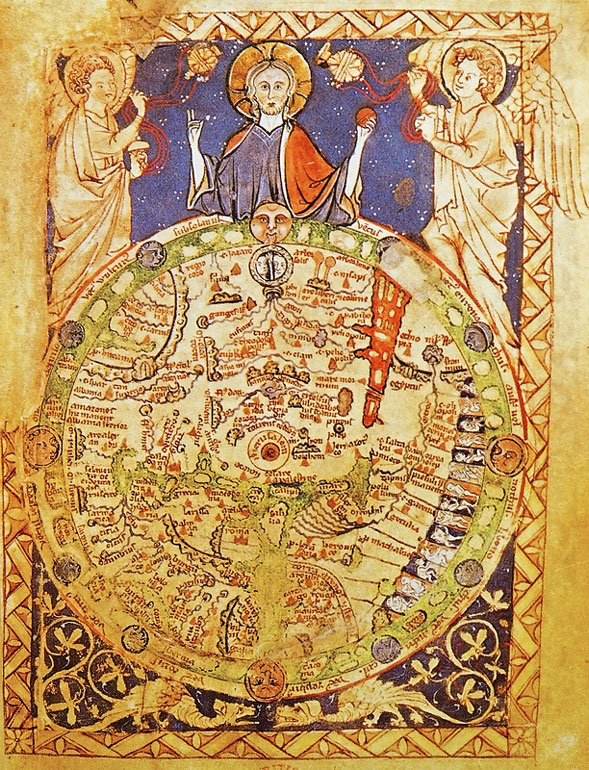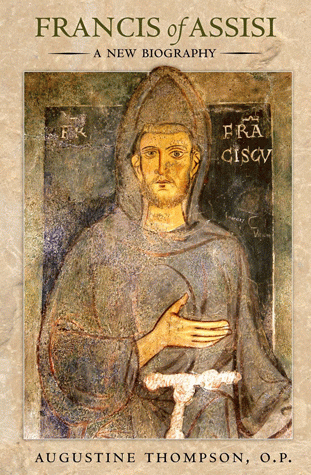When I teach about things medieval in my classes, I have the opportunity to show students how different their mental background is from those writers we are studying. One point that invariably comes as a surprise to them is the medievals, like most ancients, presumed the earth to be a sphere of about 24,000 miles in circumference. If they are familiar with that point, they are often not familiar with the point that the earth being in the “center” of the universe is not a matter of elevation, but of demotion, just as renting an apartment in the basement of a high-rise is not better than renting the penthouse.
For those who have already learned something of the imagined location of the earth in relation to the rest of the cosmos, fewer still are familiar with the imagined geography of the globe itself that underlies the thought of most medieval peoples, especially as to where Europe sits in the mental map of the world in relation to other places on the globe, and what that means.
Thus, when reading about Thomas’s description of Paradise in ST I, Q. 102, it helps to explain to my students the following map of the world:

While highly stylistic, the above image clearly represents what land is “at the top” and what land is “at the bottom” in the medieval imagination.
More detailed versions of this map are quite common, but are all “oriented” in the same manner, with the superior part of the world imagined to be at the “top” of the globe:

With this in mind, many practices and ideas become clearer: the eastward orientation of the entire congregation at Mass in the typical medieval church has everyone facing, not for some puzzling reason to the “right” on the globe, but rather “upward” toward the paradise from which man has been banished, and Jerusalem is imagined to be in the very center of the globe, hence its religious and political importance, and so on.
What is significant for reading Thomas is to understand how Europeans imagined themselves situated among those banished from Paradise, which will sometimes emerge in off-handed remarks made in the course of discussing other matters. To be in Europe was not to be at the “top” of the world, as Modern maps would have us imagine things, but rather at the bottom, down and kind of to the left. Italy wasn’t too bad a place to be, as it was closer to the center of things and from it one could more easily access those important places “up there” by means of a conveniently-located sea in the middle of the earth (hence the not-too imaginative name by which we still refer to it).
But there were those who dwelt further down that land on the bottom of the globe, where the Franks and Celts originally emerged. Yet ever further still from Paradise were those remote islands, wetter and colder, off the coast of the mainland. In this imaginative world, Ireland was perhaps as far from Paradise as one could envision, floating there on the very bottom fringe of the globe.
With all this in mind, otherwise perplexing statements in Thomas can become clear to students. This was brought to mind today when I was reading Thomas’s explanation as to why God placed Paradise where He did:
“It was fitting that it should be in the east; for it is to be believed that it was situated in the most excellent part of the earth. Now the east is the right hand on the heavens, as the Philosopher explains (De Coel. ii, 2); and the right hand is nobler than the left: hence it was fitting that God should place the earthly paradise in the east.” ST I, Q. 102, A. 1, Response
Superficially, it would seem to confirm our way of imagining the world on our modern maps, where east is on the right and west is on the left. But this would be a misinterpretation of what Thomas is arguing.
If we turn to Aristotle’s On the Heavens, from which a premise in the above syllogism is drawn to situate the east to the “right”, we see that Aristotle is discussing the principles of movement as to their origins(Up, Right and Front) and their termini (Down, Left and Back, naturally), specifically in debate with the Pythagoreans, who only speak of Right and Left as principles of the motions of the heavens. While the six principles are easy enough to understand in the case of plants and animals, the sperical shape of the heavens might lead one to argue that the six principles do not apply in the celestial case; after all, depending where you stand and which way you look, any point that previously was “up” can now become “left” and so on. Aristotle recognizes this, and defines these principles, not in relation to us as we view something, but rather as relations in the motion of the sphere itself:
“Since we have already determined that functions of this kind belong to things which possess a principle of movement, and that the heaven is animate and possesses a principle of movement, clearly the heaven must also exhibit above and below, right and left. We need not be troubled by the question, arising from the spherical shape of the world, how there can be a distinction of right and left within it, all parts being alike and all for ever in motion. We must think of the world as of something in which right differs from left in shape as well as in other respects, which subsequently is included in a sphere. The difference of function will persist, but will appear not to by reason of the regularity of shape. In the same fashion must we conceive of the beginning of its movement. For even if it never began to move, yet it must posses a principle from which it would have begun to move if it had begun, and from which it would begin again if it came to a stand.” On the Heavens, Bk. 2
If “Right” is defined as the principle of the beginning of movement, then the East will be where we can imagine the movement of the sphere of the heavens beginning (Since Aristotle’s universe and its movement is eternal, you have to imagine pressing the cosmic “pause” button, and then seeing where things would begin when you pressed “play”).
In our modern imagination, we envision the earth rotating on its axis, from left to right:

But for the medieval imagination, the earth is stationary, and it is the heavens that appear to move above in the opposite direction. And indeed, from the perspective of an outside observer looking down on a stationary earth, the celestial spheres of the stars would appear to move from the right to the left.
Recall, however, that the ancient or medieval woman or man is not imagining the movement from a bird’s-eye (God’s eye?) perspective, from outside the heavenly sphere looking down on its movement, but rather from the surface of the earth looking up. From that perspective, lying on the grassy hillside with one’s head pointing up to the North Pole, one looks up at the stars and sees them moving, but for you, they move from your left side to your right side. How then is the east to the right, and not the left?
Thomas notes this problem in his commentary on Aristotles On the Heavens, and points out that when speaking of “right” and “left” as principles of movement, you must also speak of “up” and “down”:
“Now it is manifest in the case of every animal that we call the “right” that which is the originative source of its local motion (on which account the right side of an animal is warmer, in order to be more apt for motion); but the circular motion of the heaven originates from that part whence the stars rise and which is called “east”; consequently the west will be its left. If, therefore, the motion of the heaven begins at the right and circulates back to the right, as though going from the same to the same, then necessarily the pole hidden from us, namely, the antarctic, is referred to as the upper part of the heavens, for if the arctic pole, which is never hidden from us, were the upper side, it would follow that the motion of the heaven would be from left to left. But this is not the way we speak of it.
“This will be easier to understand if we imagine a man with his head in the arctic and his feet in the antarctic poles of the heaven. His right hand will be in the west and his left in the east, provided his face is toward the upper hemisphere, i.e., the one visible to us on earth. Therefore, since the motion of the heaven is from east to west, it will follow that it is from the left to the right. On the other hand, if we place his head in the antarctic and his feet in the arctic pole, with his face as before, his right hand will be in the east and his left in the west. Then the motion would begin from the right, as it should. Thus it is clear that the heaven’s “up” is the pole which is hidden from us.” Exposition of Aristotle’s Treatise on the Heavens, Bk. 2, L. 3, n. 12
Thus, not only is the East on the Top of the earth, which is superior as it appears to us on a map, it is also superior as to the principle of motion of the heavens, for which reason God places it on the “Right” when one is speaking strictly about “places” in the sphere of the earth.
Conversely, where is Europe? Not only is it in the inferior part of the world with respect to the principles of movement, as imagined in the West as compared to the East; it is also at the “bottom” of the sphere of the earth, and one who gazes up at the North Star is actually looking at the bottom pole around which the sphere of the heavens rotates.
So the medieval theologian on the edge of the last continent, furthest from our original Paradise, nearest to the uncrossable sea, would envision themselves looking not up, but down, when they stared into the night sky (as beautifully captured in time-lapse by the photographer below):
http://www.twilightlandscapes.com/Twilight_Landscapes/Time_Lapse_-_NMSkies_Pole.html
Thus, when we come across a puzzling passage such as the syllogism that Thomas employs to explain the fittingness of the location of Paradise, I encourage students to not jump to the conclusion that we know what he means simply because we think we know our left from our right.






